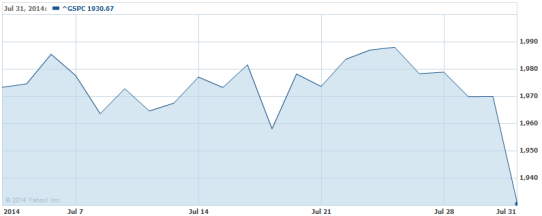Financial News Friday – August 1, 2014
As you can see from the chart above, this has been a week of steady declines in the US stock market. On Thursday alone the S&P 500 declined by 2%. With all of the current market volatility, which is very likely to continue, it’s important to have a plan. That plan could be to stick it out and “buy & hold” through the ups or downs or to rotate between the strongest asset classes using a more tactical strategy. Whatever your plan is, if it has a sound basis, then stick to it, if you don’t have a plan, get one and then stick to it.
And now the articles:
Tesla’s Gigafactory Comes Into Focus (Forbes)
On Thursday, Tesla Motors announced that it has taken the first steps to build a battery production facility in Nevada. The facility is planned to produce 50 GWh (gigawatt-hours) of batteries per year.
To put that into perspective, the regular version of the Model S has a 60KWh battery and the premium version has an 85KWh battery. If we estimate that 75% of the batteries are 60KWh and 25% are 85KWh, there could be production capacity of around 770,000 batteries (just some rough estimates, let me know if I’m off on my calculations).
Tesla’s batteries could be one of the company’s largest sources of revenue, as their battery technology is so far ahead of the competition’s designs. If it begins to sell its batteries to the competition, we may begin to see the tide for electric cars as a whole begin to turn. The range of Tesla’s batteries and economies of scale from mass production could help bring more electric cars to mainstream consumers.
S&P 500 Caps Worst Week Since 2012 as Crises Offset Data (Bloomberg)
Some economic highlights of the week:
- This week was the S&P 500’s largest drop in two years. The index is down a total of 3.1% from its top on July 24th.
- The Fed further reduced its bond buying program by $10 billion to $25 billion. As a reminder, around a year ago the Fed was still purchasing around $80 billion worth of debt instruments each month.
- Argentina’s failure to pay interest on its debts will result in a $1 billion settlement of default insurance.
Why Emerging Markets Have More Room to Run (A Wealth of Common Sense)
With all of the talk of bubbles it’s important to note that emerging markets are the most fairly valued (or undervalued) asset classes out there. Emerging markets are always a volatile ride, but over the next 7 to 10 years they are one of the only equity classes that are likely to have a positive real return (inflation-adjusted returns).
Ben Carlson at a Wealth of Common Sense makes some interesting points about emerging markets using an attractive infographic from the Economist. This includes comparisons between the size of countries’ stock markets to the size of US companies.
For example, Nestle has a similar market cap to India and Proctor & Gamble is roughly equivalent to Russia’s stock market. He also points out that 40% of the world’s economic output comes from emerging markets, but expectations are low for market growth in these markets because recent performance has been poor. This has caused valuations to remain low in these markets as shaken investors avoid them for the less volatile (until recently) developed markets.
Baby Boomers at Work While Millennials Sit Out of Job Force (Yahoo Finance)
According to the Department of Labor Baby Boomers are still working and remain a large portion of the job force. This is in spite of claims that employment numbers have been kept low because Baby Boomers have chosen to retire in lieu of reentering the workforce.
The White House goes on to state that Baby Boomers have only accounted for half of the labor force participation rate since the financial crisis. The majority of the other half has been Millennials in the 25 to 34 age bracket.

